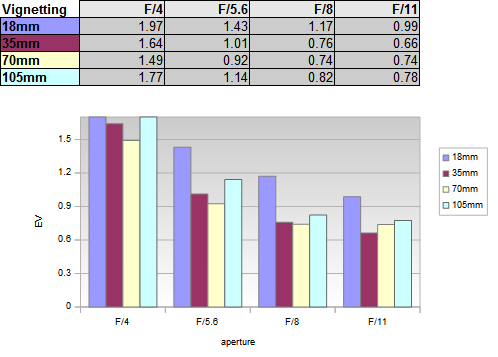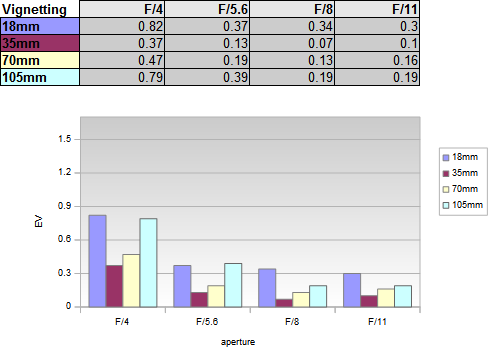|
Sony E 18-105mm f/4 G OSS ( SEL18105G ) - Review / Test - Analysis |
|
Lens Reviews -
Sony NEX
|
|
Page 2 of 3

Distortion
Let's start with the deep dark chapter first. Those who have followed the stories around this lens know it already - images are getting distorted like hell. Now this isn't quite true for the 18mm setting though. A pincushion (!) distortion of 1.4% isn't so bad really. However, beyond 18mm we are entering a surreal world. Pincushion distortions in excess of 6% were something new for us as well. It's hard to imagine why Sony considered this to be acceptable.
Now there's another way to phrase the situation - the lens just isn't meant to be used as is but you have to activate image auto-correction. This comes at cost of image quality but that's just how it is. Funnily the native pincushion distortion turns into a very mild barrel distortion between 18-70mm - albeit that's nothing to worry about really.
Vignetting
The native vignetting characteristic of the Sony E 18-105mm f/4 G OSS is about average for a lens in this class. Thus you have to live with rather heavy vignetting at wide-open aperture especially at the extremes of the zoom range. Stopping down to f/5.6 helps a bit but it's best to go for f/8 here. However, some vignetting remains at the 18mm even at f/8 and beyond.
 We can, of course, enable vignetting compensation again in the camera or during post-processing. This solves most of the issue albeit at cost of higher image noise in the image corners. Traces of vignetting may still be visible at 18mm f/4 and at 105mm f/4.
We can, of course, enable vignetting compensation again in the camera or during post-processing. This solves most of the issue albeit at cost of higher image noise in the image corners. Traces of vignetting may still be visible at 18mm f/4 and at 105mm f/4.

MTF (resolution)
In one of our previous reviews we covered the Zeiss 16-70mm f/4 OSS - which was a massive disappointment - so it's interesting whether a Sony G lens can fix that. It can ... at least partially. The quality in the image center is exceedingly high between f/4 and f/8 and that's throughout the zoom range. The borders are a different story but at least to some degree that's normal on a 24 megapixel APS-C sensor (just to give you an idea - if we assume a full format sensor with the same pixel density, we'd talk about no less than 56 megapixels). At 18mm the borders are generally good whereas the image corners are soft at f/4 but catch up from f/5.6 onward. The 35mm setting is the sweet spot of the lens with borders/corners hovering around the good to very good mark. At 70mm we can spot a quality decrease in the image corners but they recover towards f/8. The weakest setting is at 105mm. The corners are soft at f/4 and the borders don't impress either here. Stopping down improves the borders to decent levels but the corners remain less than thrilling.
The centering quality of the tested sample was Ok (slightly softer results on the right image side). The field curvature is low.
Please note that the MTF results are not directly comparable across the different systems!
Below is a simplified summary of the formal findings. The chart shows line widths per picture height (LW/PH) which can be taken as a measure for sharpness.
If you want to know more about the MTF50 figures you may check out the corresponding Imatest Explanations

Chromatic Aberrations (CAs)
Lateral CAs (color shadows at harsh contrast transitions) are quite pronounced at the extreme ends of the zoom range where they exceed an average pixel width of 2px at the image borders. The image corners are worse still here. The results are much better in the middle range.

Bokeh
Sony prides themselves of having designed a lens with a very smooth bokeh (out-of-focus blur). We agree that the general blur in the focus transition zones is rendered nicely which is unusual for a standard zoom lens.
 That being said - out-of-focus highlights show an some outlining and the inner disc is fairly busy - an effect that is getting emphasized when stopping down.
That being said - out-of-focus highlights show an some outlining and the inner disc is fairly busy - an effect that is getting emphasized when stopping down.

|